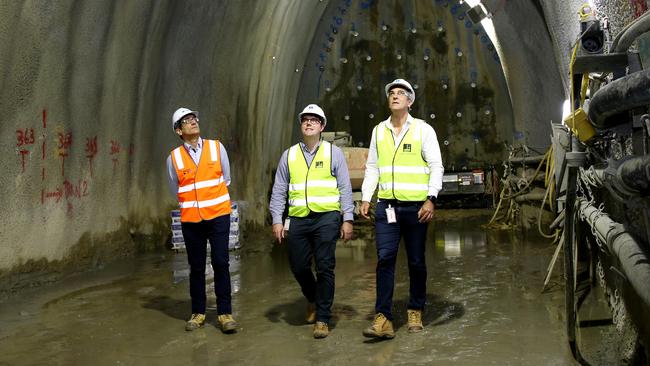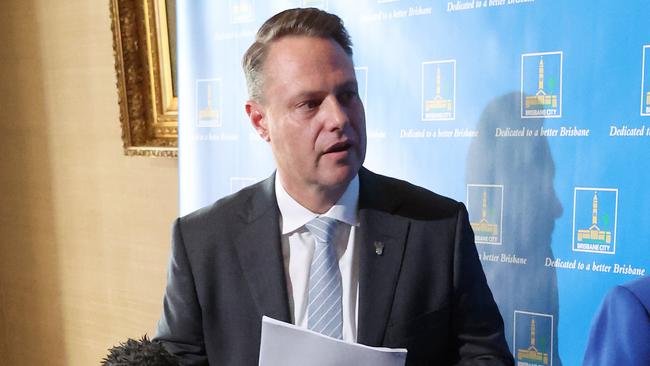Inflation and blowouts: $400m slashed from council budget
Funding has been cut from the Brisbane Metro, construction, consultants and a major green bridge as Brisbane City Council tightens its budget to deal with blowouts.
Brisbane City
Don't miss out on the headlines from Brisbane City. Followed categories will be added to My News.
Funding has been slashed from the Brisbane Metro, construction projects, consultants and a major green bridge as Brisbane City Council makes $400m worth of budget cuts to deal with inflation and cost blowouts.
Brisbane Lord Mayor Adrian Schrinner revealed the newly revised 2023-24 council budget on Tuesday, promising 86 per cent of the $1.47 billion infrastructure would be spent “in Brisbane suburbs”.
But Leader of the Opposition Jared Cassidy said the budget review was a “story of poor planning”.
The Lord Mayor said public transport, mosquito spraying, kerbside collection and cost of living measures outlined in the original budget, including summer $2 pool admissions and reduced green bin fees would remain untouched.

But cuts have been made to several infrastructure projects including $7m from Breakfast Creek Green Bridge, $2m from Fig Tree Pocket/Kenmore Rd, and $24m from the Brisbane Metro project.
Cr Schrinner said only “nice,” cosmetic aspects would be scrapped from the Metro plan, with the service still scheduled to start running at the end of next year.
“An example is we’ve reduced the contribution of public art,” he said.
“This is about adjusting the project to try and reduce the costs and keep project at an affordable level.”
Cr Schrinner promised permanent staff would not be affected by the cuts, with $70m to be slashed from IT contracts, training, travel, contractor jobs, back office efficiencies, fleet replacement, consultants, and catering.
A further $1.5m will be cut from councillor office upgrades and $1m from advertising.
“We will be reducing our expenditure on consultancies' and contractors and that is occurring, but when it comes to council staff, permanent staff have nothing to be concerned about.”
Cr Schrinner said budget cuts would allow council to prioritise keeping rates down, provide better transport and road infrastructure and incentivise housing.
But when asked if council would consider potential future cuts in line with extended inflation, he said “it’s anyone’s guess”.

“It’s anyone’s guess what’s going to happen with costs going forward, but by doing this now, we’ve created a buffer zone,” he said.
Significant post-budget cost pressures were blamed for the blowout, including a $60m decrease in infrastructure revenue and unexpected $5.9m loss in rates revenue.
“Obviously this is concerning not only because there’s a$60 million reduction in income to council but because there’s this list building activity going on out there in the community at a time when we need it more than ever,” he said.
“There’s also been a $6 million reduction in rates revenue coming in. And a big part of this is because investors are fleeing the market is selling their properties and those homes are becoming owner occupied houses.
“This is a trend that we’re seeing across the state as well. It is a disturbing trend because it means there’s fewer rental properties on the market.”
Mr Cassidy hit out at what he said was a lack of detail in the budget review about the cuts.
“Where is the rest of the money coming from?” he said.

“This review asks more questions than it answers, and Labor will keep fighting for answers.”
Brisbane councillors will have a week to review the revised budget before debating it at next week’s meeting.
The Moggill Rd Corridor upgrade experienced a $50m budget blowout, with council to pay an extra $9m to Telstra, $1.8m to APA Gas and $1.2m to Energex as part of service relocation costs, which Cr Schrinner said was “significantly higher than anticipated”.
“They’ve also taken significantly longer than anticipated,” he said.
“Unfortunately, when it comes to dealing with those utility companies, we don’t have a choice.
“There’s no competition in that space and unfortunately, they dictate the price and they dictate how they’re going to how long they’re going to take to deliver those upgrades as well, so that’s been a challenge.”
The total cost of the project now totals $233.8m.
Cr Schrinner said the road was still expected to be complete during the second half of 2024.
Other impacts included inflation remaining higher than initially forecast, a hefty cash rate increase up to 4.35 per cent and $50m worth of projects rejected by the Queensland Reconstruction Authority.
Wages also increased for more than 9000 council staff, costing an extra $4m.
Council also reported a 10.4 per cent increase in cement, a 4.6 per cent increase in electricity and a $12m loss in revenue from parking infringements.


